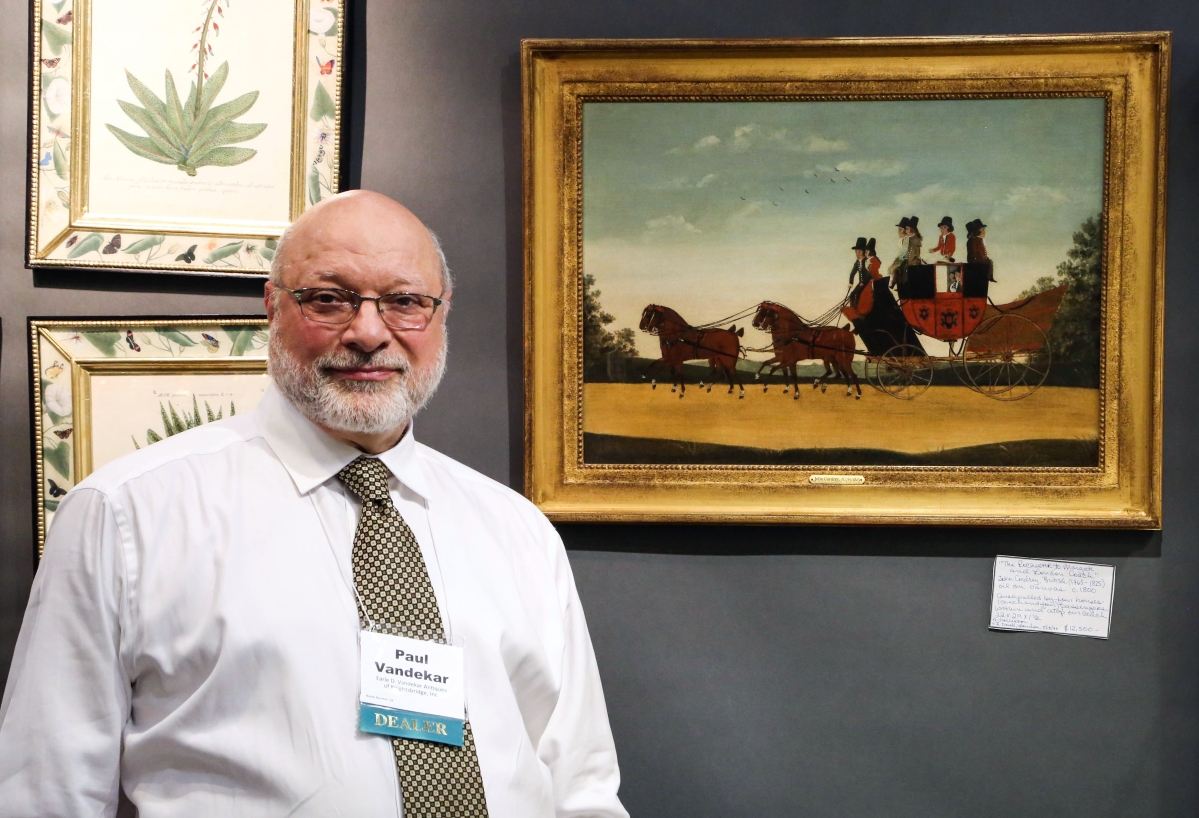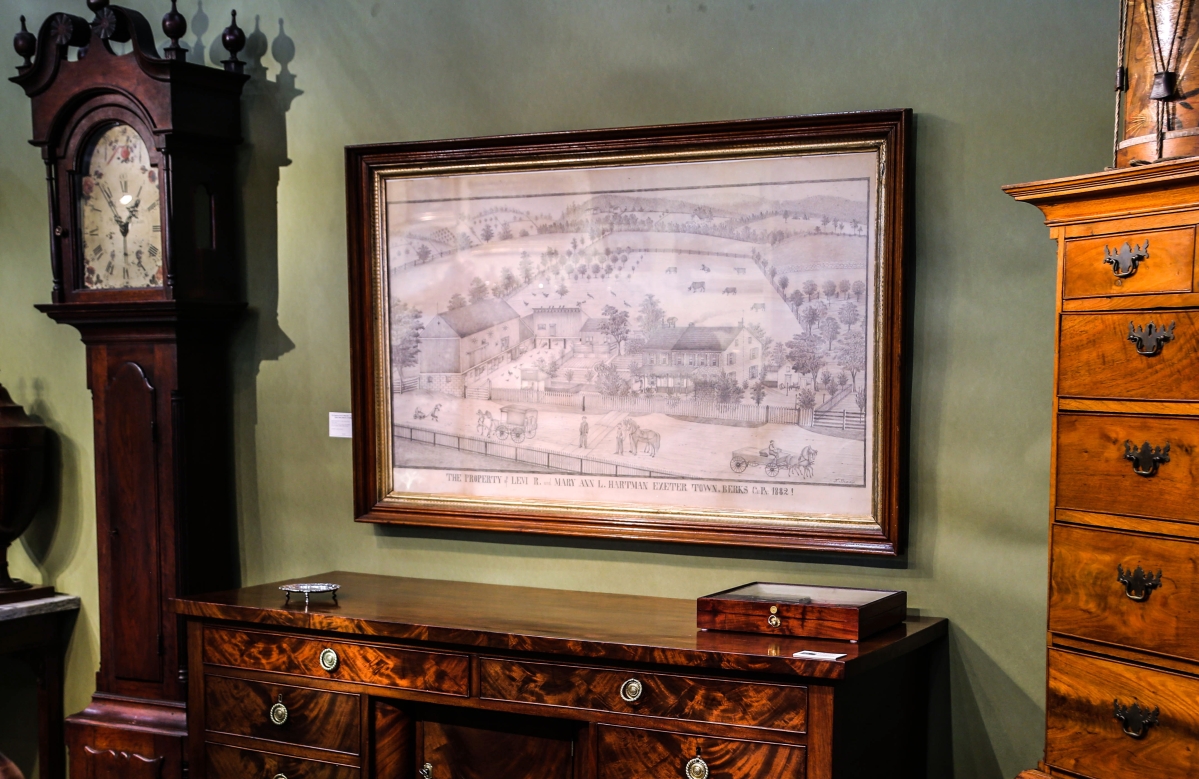
A standout in Oxford, Penn., dealer Kelly Kinzle’s booth was this pencil on paper drawing of the farm property of Levi R. and Mary Ann L. Hartman of Exeter Township, Penn. It was executed in 1882 by Ferdinand A. Brader (1833–1913).
Review and Photos by Greg Smith
MALVERN, PENN. – There are certainly many of its ilk – that is, regional antiques shows produced by the local historical association – but there are few that match the quality and energy of the Chester County Antiques and Art Show, put on in its 37th year March 15-17 by the Chester County Historical Society. Its zeal is found in the show’s central mission, which is – aside from buying antiques and artworks from the 42 exhibitors on hand – to raise funds, a benefit for the historical society and one of the largest fundraisers the organization puts on throughout the year. It is designed to preserve history through hands-on market immersion. On offer from exhibitors was a wide range of material: Pennsylvania decorative arts, furniture and artworks to more broader offerings from nearby regions, including New England furniture, American silver, weathervanes, early toys, American carvings, both Continental and American ceramics, folk art, glass and much more.
The show opened at Church Farm School with a gala party on what was the Northeast’s warmest day of 2019 up to that point.
Elizabeth Laurent, president of the Chester County Historical Society, sees the show as a high-touch exhibition.
“Here at the society, we do object-based teaching,” she told Antiques and The Arts Weekly in a follow-up call. “We like to think that what we do gets people interested in objects of the past, and what we love about the antiques show is that it’s a whole different way to learn about those things. People can sit on them, touch them and learn from the antiques dealers, who are happy to explain things. It’s a whole different way to get people interested in objects of the past. We look at it as complimentary to what we do with the society. We don’t let people touch our things or take them home, but at the antiques show, that’s fair game.”
Although the gala was widely attended and weather was favorable, dealer sales were a mixed bag. Some sold a few things, some sold nothing. Some, like Michael Weinberg of West Pelham Antiques, sold up to the closing bell, ringing up a creamware mug, a miniature watercolor and a Pennsylvania fraktur within 20 minutes of the show closing on Sunday. Regardless of how they sold, all of the dealers we spoke with credited the society with accolades for a well-managed show.
While some dealers weave a narrative through their offerings, James L Price’s exhibition conveyed a very simple message: the Carlisle, Penn., dealer was there to sell Pennsylvania furniture. In tall case clocks, the dealer brought a standout in a 1772 walnut example in the Chippendale style from John Jackson, a Chester County clockmaker who was a British loyalist. Other Chester County pieces included a Chippendale figured walnut slant front desk signed by cabinetmaker John Warner and dated to the end of the Eighteenth Century. Warner was known to sign the bottom of his drawers, and this example was no different. Price displayed the drawer and its signature on the wall behind. Also from Chester County was a Chippendale walnut tall chest of drawers with a shell-carved center drawer and inlaid with the initials “MP,” circa 1780.
Philip Bradley and Lisa Minardi brought a selection of Chester County needleworks to exhibit alongside case pieces from the area. In its original mahogany frame was an 1827 needlework by Hannah Levis (1810-1836) embellished with birds, trees, a house, flowers and the words “Emblem of Innocence.” One of a group made for a German Lutheran community in Northern Chester County was a circa 1776 chest-over-drawers of walnut with mixed-wood inlay. A walnut tall clock by Ellis and Isaac Chandlee joined the group. Although separated by the Mason-Dixon line and associated with Nottingham, Md., the Chandlees were known to provide clocks to areas of Chester County.

Joseph J. Lodge, Lederach, Penn., put together a nice display of Pennsylvania art and furniture. Among fine art, the dealer featured a selection of works from the New Hope School, including paintings by Antonio Martino, Walter Baum and Fern Coppedge.
A series of folk art cartoons on postcards drawn by Reading, Penn., politician James Maurer (1864-1944) were found in the booth of Lisa S. McAllister, Clear Spring, Md. Dating to the 1930s, the cartoons tackle social issues, like a preacher asking a father and his daughter “do you take this child to be your lawful and Christian wedded wife” with the words “In the state where you dare not teach evolution” above. McAllister also featured a complete set of French or German papier-mâché skittles in the form of brightly colored roosters. They were from the late Nineteenth Century and in extraordinary condition.
Pittsburgh dealer Harley Niles Trice American Antiques and Fine Art was showing off a number of items birthed in Pennsylvania. Trice specializes in Pittsburgh glass, an interest that has descended in his family for generations, beginning with his great-great-grandfather, who was himself a Pittsburgh glass blower for the Bryce Brothers Company. Trice was showing off a cobalt and clear glass pitcher with twisted red, white and blue coloration in the clear glass handle, known as Captain Pete’s Pitcher. The name was descendant from its earliest known owner, who was the captain of a steamboat that sailed along the three rivers that converge in the city: the Allegheny, Monongahela and Ohio.
AJ Warren of Peter and Maria Warren Antiques, Monroe, Conn., related that she had a successful show selling from her collection of English pottery. Notable among her offerings was a circa 1755 teapot, buff-colored with creamware applied relief and tri-feet with a crabstock handle and spout. The dealer also showed off a pair of Ralph Wood Romulus and Remus figurines, the angelic cherub subjects each riding a finely detailed male and female lion. Among sales, Warren reported that she wrote up a circa 1760 English tortoiseshell-glazed lion, a circa 1770 English Greatbatch teapot and a few other small pieces.
Representing Leatherwood Antiques, Sandwich, Mass., dealers Mo Wajselfish and Johnny Young reported strong sales, including a standout in their booth: an elaborately carved and painted marriage chair dated 1842 from the Schwalm region of Germany. The rush-seat chair was paint-decorated and carved with tulips, birds, pinwheels and hearts with the name of its recipient, Anna Elisabeth Kraus, emblazoned across its crest rail. Other sales included a variety of animals from the dealer’s collection of Black Forest carvings and Vienna bronzes. Foxes were a desirable form, according to Wajselfish, and he sold a number of them.
“It is absolutely a worthwhile show,” Wajselfish told Antiques and The Arts Weekly. “It’s a very important show for us. The patrons who support the show are also customers of ours.”

Philip Bradley stands before a 1776 Chester County chest-over-drawers in walnut with mixed-wood inlay. The large 1827 needlework at the top comes in its original mahogany frame and was worked by Hannah Levis (1810–1836).
But Wajselfish also noted that he has a handful of “snowbird” clients who support the show but have not returned from the South in time for the event. He noted they are happy to buy from a catalog as the event approaches and credits the show for those sales.
West Chester, Penn., dealer H.L. Chalfant showcased a handful of paintings by Pennsylvania artists, including German-born Herman Herzog, who moved to Philadelphia in the 1860s, and his pupil, George Cope. Cope’s finely detailed paintings ranged from a still life in an oil on canvas of “Fruit and A Glass On White Tablecloth,” dated 1925, to landscapes in “Landscape With A Stream,” dated 1900, and a “Bucolic Riverscape With Cows,” dated 1909, and trompe l’oeil works, including a remarkable still life featuring a table scene centered on a halved watermelon among other fruit, dated 1916, and an oil on paper on canvas of peaches on a white tablecloth, dated 1893. Herzog’s work in the exhibition was titled “On the Lapland Coast,” circa 1890, featuring a caribou standing on the shores of a body of water as an impending storm is seen creeping in. Chalfant shared two sales with us, including a raised panel high chest and a miniature blue painted blanket chest.
Kelly Kinzle related sales of a Chester County walnut and pine high chest on frame, circa 1770, and a tilt top table. The New Oxford, Penn., dealer also featured an impressive pencil on paper drawing by Ferdinand A. Brader (1833-1913). The drawing depicted the farm property of Levi R. and Mary Ann L. Hartman of Exeter Township, Penn., 1882. Brader, who later moved from Berks County to Ohio, would always draw himself into his work, and Kinzle assumed he was one of the male figures at the forefront.
Robesonia, Penn., dealer Greg Kramer featured an exhibition of smalls, including a wall display of ten Pennsylvania frakturs. They were joined by a good folk art scene titled “An Old New England Fireside & Kitchen,” depicting a carved interior scene of that nature with many carved elements, including dozens of pots and pans, decorative elements on the fireplace mantle and a rifle hung above it, jars in the corner cupboard, a spinning wheel, a tall clock and more, all in its original crusty surface.
Although the fundraising totals will not be known until May, Laurent signaled that the event was successful and she was pleased with it. The funds will help the society with its development of their core exhibitions as well as smaller changing exhibits that rotate throughout the year.
For additional information, www.chestercohistorical.org or 610-692-4800.
































